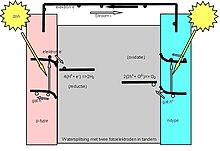Photoelectrochemical cell
Photoelectrochemical cells or PECs are solar cells and convert visible light into electrical energy . A cell consists of a semiconductor photoanode, a metal cathode and an electrolyte . The cells either generate electrical energy directly or they generate hydrogen in a process similar to the electrolysis of water.
Photogeneration cell
In this type of photoelectrochemical cell, water is separated into hydrogen and oxygen in electrolysis when the anode is irradiated with light. This allows hydrogen to be produced with an efficiency of around 10%.
The biggest problem, however, is the corrosion of the semiconductor , which comes into direct contact with the water. For this reason, only smaller laboratory samples of no economic importance are in use.
Grätzel cell
Grätzel cells or dye solar cells use nanoporous titanium oxide (TiO 2 ) to generate electrical energy.
